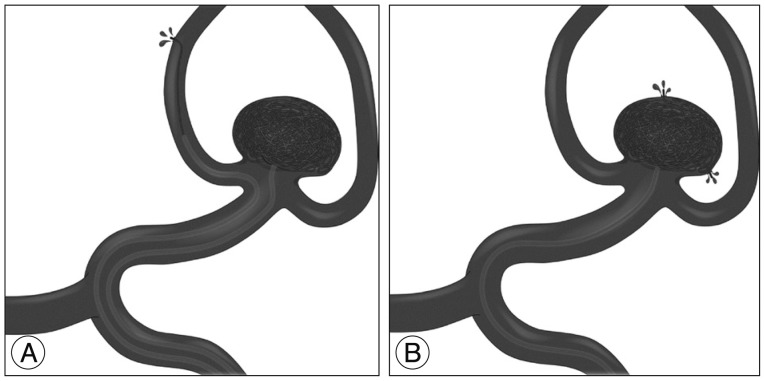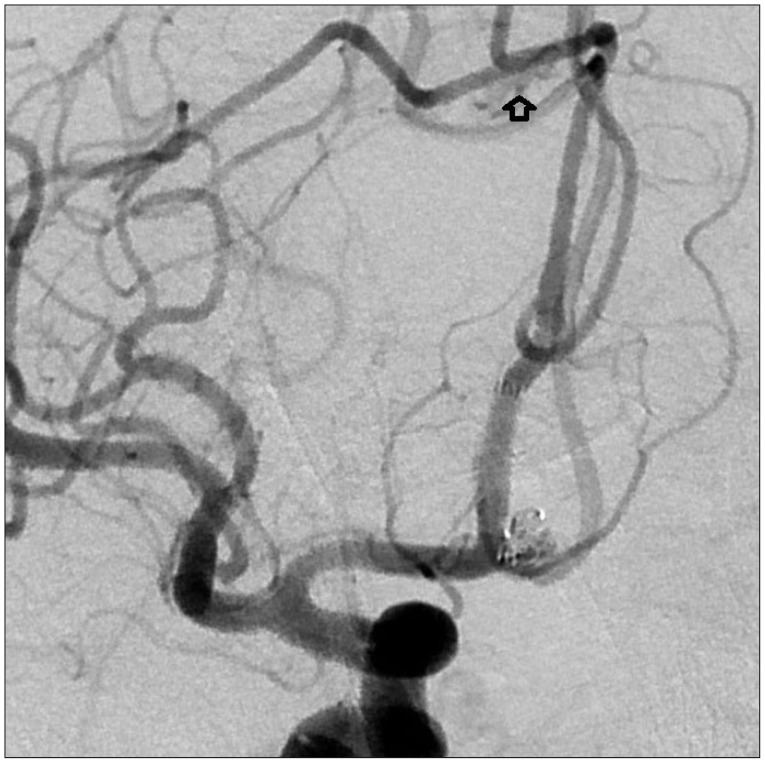J Korean Neurosurg Soc.
2016 Jan;59(1):6-10. 10.3340/jkns.2016.59.1.6.
Predictor and Prognosis of Procedural Rupture during Coil Embolization for Unruptured Intracranial Aneurysm
- Affiliations
-
- 1Department of Neurosurgery, Samsung Medical Center, Sungkyunkwan University School of Medicine, Seoul, Korea. schongns.hong@samsung.com
- 2Department of Radiology, Samsung Medical Center, Sungkyunkwan University School of Medicine, Seoul, Korea.
- KMID: 2152912
- DOI: http://doi.org/10.3340/jkns.2016.59.1.6
Abstract
OBJECTIVE
The objectives of this study was to determine the incidence and outcomes of procedural rupture (PR) during coil embolization of unruptured intracranial aneurysm (UIA) and to explore potential risk factors.
METHODS
This retrospective study evaluated 1038 patients treated with coil embolization between January 2001 and May 2013 in a single tertiary medical institute. PR was defined as evidence of rupture during coil embolization or post procedural imaging. The patient's medical records were reviewed including procedure description, image findings and clinical outcomes.
RESULTS
Twelve of 1038 (1.1%) patients showed PR. Points and time of rupture were parent artery rupture during stent delivery (n=2), aneurysm rupture during filling stage (n=9) and unknown (n=1). Two parent artery rupture and one aneurysm neck rupture showed poor clinical outcomes [modified Rankin Scale (mRs) >2] Nine aneurysm dome rupture cases showed favorable outcomes (mRS < or =2). Location (anterior cerebral artery) of aneurysm was associated with high procedural rupture rate (p<0.05).
CONCLUSION
The clinical course of a patientwith procedural aneurysm rupture during filling stage seemed benign. Parent artery and aneurysm neck rupture seemed relatively urgent, serious and life threatening. Although the permanent morbidity rate was low, clinicians should pay attention to prevent PR, especially when confronting the anterior cerebral artery aneurysm.
MeSH Terms
Figure
Reference
-
1. Abdihalim MM, Chaudry SA, Tariq N, Suri MF, Qureshi AI. The natural history of "contrast stasis" within aneurysm after embolization. J Vasc Interv Neurol. 2013; 5:14–21. PMID: 23460932.2. Elijovich L, Higashida RT, Lawton MT, Duckwiler G, Giannotta S, Johnston SC. Cerebral Aneurysm Rerupture After Treatment (CARAT) Investigators. predictors and outcomes of intraprocedural rupture in patients treated for ruptured intracranial aneurysms : the CARAT study. Stroke. 2008; 39:1501–1506. PMID: 18323484.
Article3. Fernandez Zubillaga A, Guglielmi G, Viñuela F, Duckwiler GR. Endovascular occlusion of intracranial aneurysms with electrically detachable coils : correlation of aneurysm neck size and treatment results. AJNR Am J Neuroradiol. 1994; 15:815–820. PMID: 8059647.4. Gerlach R, Beck J, Setzer M, Vatter H, Berkefeld J, Du Mesnil de Rochemont R, et al. Treatment related morbidity of unruptured intracranial aneurysms : results of a prospective single centre series with an interdisciplinary approach over a 6 year period (1999-2005). J Neurol Neurosurg Psychiatry. 2007; 78:864–871. PMID: 17210624.
Article5. Gonzalez N, Sedrak M, Martin N, Vinuela F. Impact of anatomic features in the endovascular embolization of 181 anterior communicating artery aneurysms. Stroke. 2008; 39:2776–2782. PMID: 18617670.
Article6. Hademenos GJ, Massoud TF, Turjman F, Sayre JW. Anatomical and morphological factors correlating with rupture of intracranial aneurysms in patients referred for endovascular treatment. Neuroradiology. 1998; 40:755–760. PMID: 9860129.
Article7. Hernesniemi J, Dashti R, Lehecka M, Niemelä M, Rinne J, Lehto H, et al. Microneurosurgical management of anterior communicating artery aneurysms. Surg Neurol. 2008; 70:8–28. discussion 29PMID: 18452980.
Article8. Hwang G, Jung C, Sheen SH, Park H, Kang HS, Lee SH, et al. Two-year follow-up of contrast stasis within the sac in unruptured aneurysm coil embolization : progressive thrombosis or enlargement? AJNR Am J Neuroradiol. 2010; 31:1929–1934. PMID: 20634307.
Article9. Jeong YG, Jung YT, Kim MS, Eun CK, Jang SH. Size and location of ruptured intracranial aneurysms. J Korean Neurosurg Soc. 2009; 45:11–15. PMID: 19242565.
Article10. Jo KI, Yeon JY, Kim KH, Jeon P, Kim JS, Hong SC. Predictors of thromboembolism during coil embolization in patients with unruptured intracranial aneurysm. Acta Neurochir (Wien). 2013; 155:1101–1106. PMID: 23624636.
Article11. Kakalis NM, Mitsos AP, Byrne JV, Ventikos Y. The haemodynamics of endovascular aneurysm treatment : a computational modelling approach for estimating the influence of multiple coil deployment. IEEE Trans Med Imaging. 2008; 27:814–824. PMID: 18541488.
Article12. Kang DH, Hwang YH, Kim YS, Bae GY, Lee SJ. Cognitive outcome and clinically silent thromboembolic events after coiling of asymptomatic unruptured intracranial aneurysms. Neurosurgery. 2013; 72:638–645. discussion 645PMID: 23277379.
Article13. Kunz M, Bakhshai Y, Zausinger S, Fesl G, Janssen H, Brückmann H, et al. Interdisciplinary treatment of unruptured intracranial aneurysms : impact of intraprocedural rupture and ischemia in 563 aneurysms. J Neurol. 2013; 260:1304–1313. PMID: 23263594.
Article14. Loewenstein JE, Gayle SC, Duffis EJ, Prestigiacomo CJ, Gandhi CD. The natural history and treatment options for unruptured intracranial aneurysms. Int J Vasc Med. 2012; 2012:898052. PMID: 22500236.
Article15. Molyneux AJ, Kerr RS, Yu LM, Clarke M, Sneade M, Yarnold JA, et al. International subarachnoid aneurysm trial (ISAT) of neurosurgical clipping versus endovascular coiling in 2143 patients with ruptured intracranial aneurysms : a randomised comparison of effects on survival, dependency, seizures, rebleeding, subgroups, and aneurysm occlusion. Lancet. 2005; 366:809–817. PMID: 16139655.
Article16. Morales HG, Kim M, Vivas EE, Villa-Uriol MC, Larrabide I, Sola T, et al. How do coil configuration and packing density influence intra-an-eurysmal hemodynamics? AJNR Am J Neuroradiol. 2011; 32:1935–1941. PMID: 21885712.
Article17. Santillan A, Gobin YP, Greenberg ED, Leng LZ, Riina HA, Stieg PE, et al. Intraprocedural aneurysmal rupture during coil embolization of brain aneurysms : role of balloon-assisted coiling. AJNR Am J Neuroradiol. 2012; 33:2017–2021. PMID: 22555586.
Article18. Soeda A, Sakai N, Sakai H, Iihara K, Yamada N, Imakita S, et al. Thromboembolic events associated with Guglielmi detachable coil embolization of asymptomatic cerebral aneurysms : evaluation of 66 consecutive cases with use of diffusion-weighted MR imaging. AJNR Am J Neuroradiol. 2003; 24:127–132. PMID: 12533341.19. UCAS Japan Investigators. Morita A, Kirino T, Hashi K, Aoki N, Fukuhara S, et al. The natural course of unruptured cerebral aneurysms in a Japanese cohort. N Engl J Med. 2012; 366:2474–2482. PMID: 22738097.
Article20. Uemura A, Kamo M, Matsukawa H. Angiographic outcome after endovascular therapy for anterior communicating artery aneurysms : correlation with vascular morphological features. Jpn J Radiol. 2012; 30:624–627. PMID: 22760947.
Article21. Vlak MH, Algra A, Brandenburg R, Rinkel GJ. Prevalence of unruptured intracranial aneurysms, with emphasis on sex, age, comorbidity, country, and time period : a systematic review and meta-analysis. Lancet Neurol. 2011; 10:626–636. PMID: 21641282.
Article
- Full Text Links
- Actions
-
Cited
- CITED
-
- Close
- Share
- Similar articles
-
- Combined Endovascular and Microsurgical Procedures as Complementary Approaches in the Treatment of a Single Intracranial Aneurysm
- Management of Unruptured Intracranial Aneurysms
- Self-Efficacy and Self-Care Behavior in Patients with Unruptured Intracranial Aneurysm after Treatment with Coil Embolization
- Delayed Complications after Uneventful Coil Embolization of Unruptured Aneurysms : Case Report
- Retrieval of Unintended Migrated Detached Coil: Case Report



